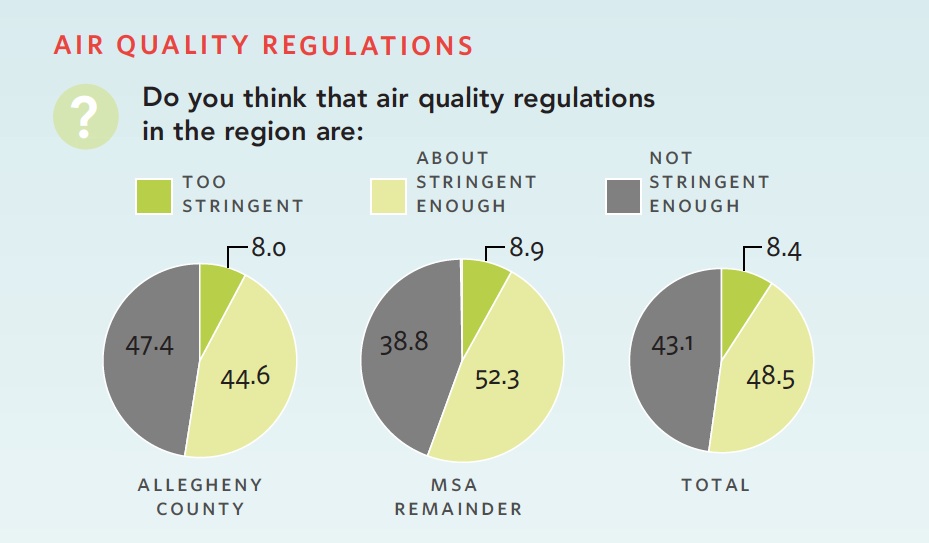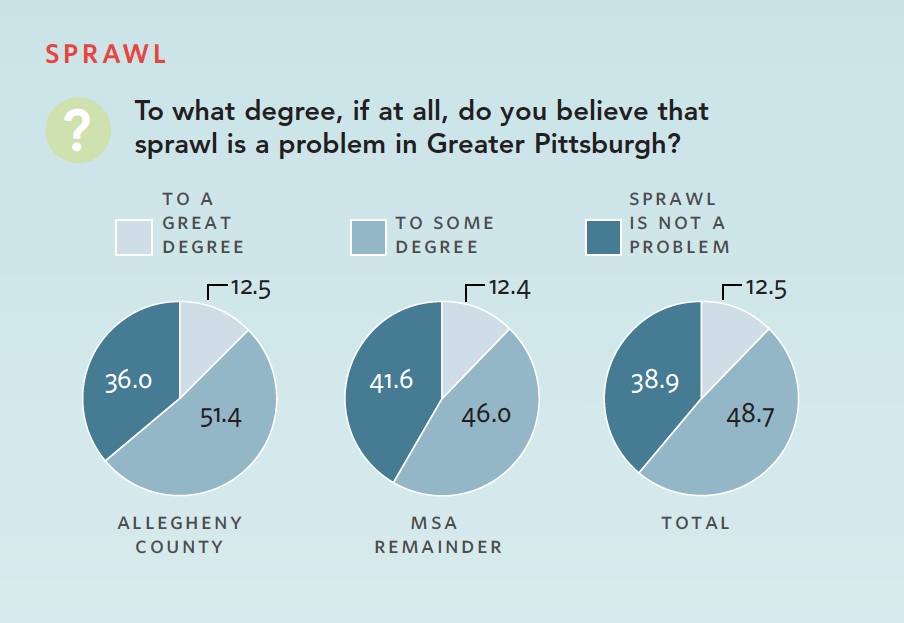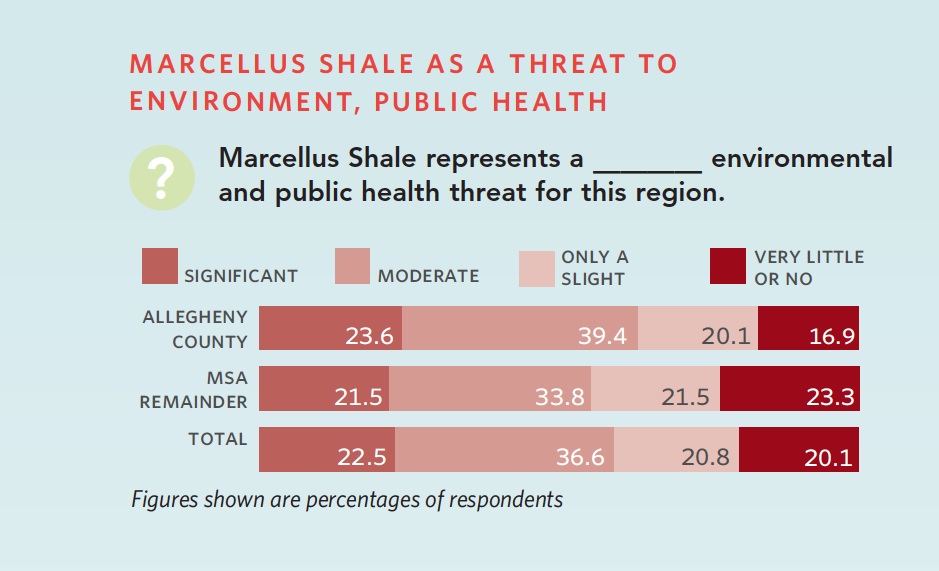A groundbreaking survey examines behaviors, attitudes and priorities
Lori Rieger and Kim Haynes are strolling Point State Park on a July afternoon that is sunny, hot and humid enough to notice. It’s the kind of day that invites ozone pollution to accumulate at levels that violate federal air quality standards, which is something Pittsburgh and the region do on an annual basis. But if it’s a problem, Rieger doesn’t see it.
“I don’t know anything about breathing difficulties or asthma,” says Rieger, who lives north of the city in Ross. “We don’t see it in our circle—that anyone has breathing difficulties or problems. I don’t think we have a lot of industry anymore that would lend itself to bad air. The humidity is always an issue, but I don’t think that’s air quality. It’s more weather-related.”

Her perception belies the fact that long after the smoky steel industry became a shadow of its former self, the air she breathes is still too thick with barely visible ozone and fine particulate pollution to be considered healthy by Environmental Protection Agency standards. But she’s not alone. Hers is a view that nearly two-thirds of southwestern Pennsylvania residents share, according to a new regional survey on the environment.
More than 800 men and women living in the seven-county Pittsburgh Metropolitan Statistical Area (MSA) were interviewed for the phone survey conducted in May by the University of Pittsburgh University Center for Social and Urban Research (UCSUR) and Pittsburgh Today. The results provide an extensive profile of their environment-related behaviors and views on issues ranging from air and water quality to government regulation, Marcellus Shale drilling, and climate change.
What emerges is a regional population that generally acknowledges climate change as a problem, but is divided on whether human activity or a natural warming cycle is mostly to blame. They’re less concerned about the quality of the air than they are about the conditions of the region’s rivers and streams. Most take steps to curb their energy use, but are less likely to park the car in favor of walking, biking or taking the bus once in a while. More support drilling for natural gas in the Marcellus Shale than oppose it, as long as it’s not done in state parks, game lands and wildlife reserves. And an overwhelming majority of residents believe they share responsibility in solving environmental problems, but feel they have little chance of making a difference.
Lingering misconceptions
North Side resident John Robert senses that all is not right with the quality of the air. “I can see that there can be some improvements in the North Side. I get up in the morning and my car is always covered in a fine, fine coating of something,” he says while taking in the fountain at Point State Park with his wife, Carol, and their grandchildren. “They say it’s coming from the Ohio Valley,” Carol says.
“Well, it’s here anyway, wherever it comes from,” he replies. “It’s not as good as it could be.”
In 2011, the region managed to fall within the annual limits for fine particulate pollution for the first time in nearly 15 years. But now that the EPA has tightened those limits, the region is expected to fall short again. It also consistently fails to meet limits for ozone pollution—also known as smog—which forms when sunlight reacts with exhaust from motor vehicles and other fossil fuel-burning sources, and can exacerbate asthma and other cardio-pulmonary problems. Compounding the region’s air problems is the fact that it is downwind from prolific sources of both pollutants, such as the coal-fired power plants that crowd the Ohio River Valley.

The Roberts’ understanding of such issues puts them squarely among the minority of residents in the region. Some 65 percent of residents in the Pittsburgh MSA see air quality as either a minor problem or not a problem at all. Only 5 percent see it as a severe problem, while 35 percent feel it’s not a problem at all. The Pittsburgh MSA includes Allegheny, Armstrong, Beaver, Butler, Fayette, Washington and Westmoreland counties.
Such findings are consistent with the gap between perceptions of air quality and pollution data found in previous surveys that addressed the issue: a 2011 Quality of Life Survey also done by UCSUR and Pittsburgh Today and online surveys by the Breathe Project, a regional air quality initiative launched by The Heinz Endowments. The difference is May’s Pittsburgh Today survey finds the gap to be much narrower. For instance, 81 percent of Pittsburgh MSA residents in the Quality of Life Survey felt air quality was either a minor problem or not a problem at all.
The precise reasons for the difference are unclear. One possibility is the survey sample. People who agree to take part in surveys focused on a single issue—in this case, the environment—are usually more likely to have an awareness of and interest in that issue, compared to those who take a survey that asks them about a range of disparate issues, such as the Quality of Life Survey, which covered everything from local arts and the economy to environment and crime.
Among those randomly selected for the most recent environment survey, only about 18 percent admitted having no knowledge about environmental issues such as air and water quality. Another 72 percent viewed themselves as “somewhat knowledgeable” and 9 percent as “extremely knowledgeable.” More than 18 percent described themselves as active in the environmental movement, though their level of involvement was not defined. And only 5 percent were unsympathetic toward the environmental movement.
Another possibility is that the public has become more aware of the region’s air quality issues. Those issues have received wide media coverage in recent years. And a well-financed public awareness campaign around air quality issues has been a staple of the Breathe Project. In fact, surveys commissioned by the project suggest awareness of local air quality issues has risen among the public at large, policymakers and community leaders.
Several possible ways to address the region’s air quality problems drew the support of a majority of residents interviewed in the recent Pittsburgh Today survey, but placing greater restrictions on wood burning wasn’t one of them. Instead, about two-thirds—and in some cases, more—of people in the Pittsburgh MSA support spending more on public transportation, and putting tighter controls on industrial emissions and emissions from coal-burning power plants.
Rivers of concern
With its abundant annual rainfall, southwestern Pennsylvania’s challenge is not the availability of water, but effective stewardship to protect the quality of its rivers and streams—something that has not been its strong suit. Pennsylvania Department of Environmental Protection data show that 6,561 miles of impaired streams and rivers flow through the Pittsburgh MSA and eight surrounding counties. The problems are long-standing and stem from insults ranging from overburdened municipal sewage systems to acids traced to abandoned coal mines.
The Pittsburgh Today environment survey suggests this is an issue of concern for most of the region’s residents. Across the Pittsburgh MSA, more than two-thirds of residents describe pollution of rivers and streams as a severe or moderate problem. And the rate is higher in Allegheny County, which has the largest concentration of streams in the region that don’t meet EPA water quality standards.
The region’s most complex and expensive water problem is also found in Allegheny County, where even a modest rain causes raw sewage to overflow into rivers and streams from aged and overtaxed city and suburban sewer systems. Some 70 percent of county residents surveyed river and stream pollution as a severe or moderate problem, yet only 48 percent describe sewage runoff in those terms. And nearly 18 percent say it’s not a problem at all. Such perceptions suggest many are in for sticker shock. Fixing the sewage overflow problem is estimated to cost at least $2.8 billion, which would double the current consumer sewage rate.
One of the byproducts of the region’s lingering water pollution issues has been the development of water treatment systems that are considered among the best in the country. And most residents seem satisfied. Nearly two-thirds report only minor problems with the quality of drinking water or no problems at all. They also report not using much of it.
Average personal water consumption in Pennsylvania has soared from 5 gallons per person per day in 1900 to 62 gallons, according to DEP estimates. For a family of four, that would be about 250 gallons a day. The survey suggests most southwestern Pennsylvanians underestimate their daily household water usage or are exceptionally frugal when it comes to bathing, washing their car and watering their lawn. More than 78 percent of them estimate their household uses 50 or fewer gallons a day with 38 percent putting their consumption at 25 gallons or less.
Going green, with exceptions
Most residents think highly of their own efforts to protect the environment. Nearly 60 percent overall feel they are doing an excellent or good job in that regard and those most likely to say so live in counties outside of Allegheny. Various self-reported behaviors lend support to those lofty assessments, for the most part.
A whopping 95 percent claim they turn off lights and electronics in unoccupied rooms. About 63 percent turn down the heat in the winter at night and roughly the same percentage do so with the air conditioning in the summer. About 74 percent make an effort to take shorter showers, limit watering the lawn and reduce their water consumption in other ways. Nearly 3 in 4 residents regularly recycle glass, plastic and newspapers. And more than 74 percent upgraded to an energy-saving appliance during the past year.
They’re still wedded to their cars, trucks and vans, of course. More than 58 percent overall didn’t reduce car trips during the past 12 months by taking a bus or by carpooling, walking or biking. The percentages in rural counties are similar to those in Allegheny County, where public transit is more abundant and more residents are likely to live within walking or biking distance to stores, entertainment venues and their jobs.
And fewer than half of all residents in the region took steps to make their homes more energy efficient in the past year, although 10 percent did have a home energy audit done.
The survey shows more residents have hunting and/or fishing licenses than two years earlier, yet they only account for 1 in 4 residents in the MSA and less in Allegheny County. That’s not to say they’re homebodies. Like Rieger and Haynes on that early July afternoon, most make use of the region’s parks and trails and are pleased with them.
Taken by the parks
The two Ross friends inevitably ended up seated on the edge of the Point State Park fountain, gushing with praise. “Wow,” says Rieger. “We just sat here and thought, ‘this is so phenomenal.’ If we didn’t know we were in Pittsburgh, we could be in Paris, or anywhere. It’s just fabulous.”Nearly 3 in 4 southwestern Pennsylvanians give the quality of the region’s parks and trails high marks, though most are not as enamored as Rieger. About 12 percent rate them as excellent, with another 63 percent grading them as “very good” or “good.”
“We’ve been to parks like the Mall in D.C. and stuff like that, those kind of places,” says Bonnie Shacreaw of Blairsville, Indiana County, during a recent visit to Pittsburgh to bike the city’s riverfront trails with her husband. “I think these are better. They’re more user-friendly. The people are friendlier.”

The survey suggests most residents base their assessment of the parks and trails on firsthand knowledge. Some 64 percent overall say they use them at least six times a year. And only 12 percent never do. Those who use them most often live in Allegheny County, where 40 percent of residents surveyed report visiting parks and trails at least 20 times a year. Rieger is one of them. “My son played at the Regatta, so we come down for music. We come down for exercising, walking, people-watching.” In terms of recreation, southwestern Pennsylvanians are clearly land-lovers. Only 37 percent say they use the rivers and streams more than five times a year. And more than one-third never take to the water at all.
The shale question
Residents are conflicted when it comes to drilling for natural gas trapped in the Marcellus Shale formation that runs deep beneath the region, which has emerged as the most controversial local environmental issue in decades. On one hand, 79 percent see drilling as a significant or moderate economic opportunity for the region, yet 59 percent are wary of the implications for the environment and public health, seeing it as a significant or moderate threat to both.
Despite such concerns, more Pittsburgh MSA residents support drilling than are opposed to it by a margin of 48 percent to 29 percent. The rest are on the fence. The latest reading on how they feel about shale gas drilling finds the rate of opposition has stayed the same while support has risen from 40 percent to 48 percent since 2011, when the same questions were asked in the UCSUR-Pittsburgh Today Quality of Life Survey.
But the percentage of residents who consider drilling to be a significant or moderate threat to the environment and public health hasn’t changed. And their support has limitations. No fewer than 7-in-10 residents oppose drilling in state parks, game lands, and wildlife and nature reserves.

They also overwhelmingly favor transparency in the gas industry that is enforceable by law. More than 95 percent of resident across the region believe drilling operators should be legally required to publicly disclose all of the chemicals they use in the fracking process.
Worried about warming
Marcellus Shale drilling may be the most debated environmental issue in the region, but the global stage belongs to climate change. In southwestern Pennsylvania, that debate is less about whether the climate is changing than it is about what is causing it to do so.
More than 64 percent of all residents in the Pittsburgh MSA describe climate change as a severe or moderate problem. Allegheny County residents are more likely to feel that way than those who live outside the county. When age is considered, senior citizens are the most likely to express the greatest concern. Only 18.5 percent of all residents don’t think it’s a problem.
They are more closely divided on whether climate change is due more to pollution from industry and other human activities or natural changes in the environment. More than 56 percent of all residents are of the opinion that we humans are mostly to blame, with Allegheny County residents and young adults between the ages of 18 and 29 the most likely to think so.
The burden of responsibility
A little more than half of southwestern Pennsylvanians believe the overall quality of the environment is improving, although when asked to rate it, slightly more grade it as “poor” or “fair” than as “good” or “excellent.”
To better protect it, nearly two-thirds favor expanded state government oversight. And most feel there is little economic risk in doing so. Nearly 83 percent don’t believe tighter regulations threaten their jobs. And 7 in 10 believe environmental regulations either strengthen the economy or have minimal impact.
But when it comes to solving environmental problems, more feel the burden of responsibility falls on industry and on themselves than on government. Their dilemma is that they generally feel powerless to do anything about it. Some 79 percent of southwestern Pennsylvanians believe they can do little or nothing about the region’s environmental challenges. The level of pessimism transcends geographic boundaries. And the survey suggests the least hopeful are senior citizens and young adults.




